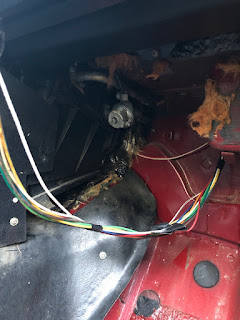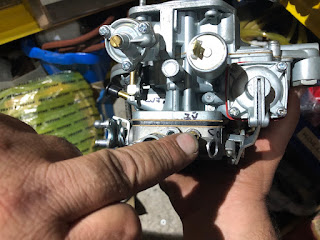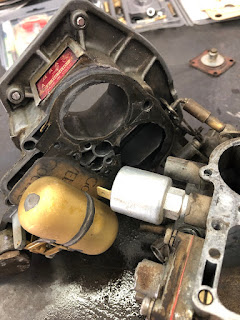I am not entirely sure how you would call the engine compartment of your esteemed classic vehicle, but for reasons, which soon shall become obvious, Comrade Car's is referred to as "Pandora's box".
So as a first step, let's dress up the engine a bit as that will surely be the best way to approach any starting or running issues. (On a more serious note: I had to swap the valve cover, because the older Weber-license carb needs a different mounting point for the carb linkage, which is part of the valve cover.)
It's not like it wouldn't run on the previously installed Solex carb, but the
amount of vacuum and coolant lines going to and from the carb, plus a solenoid
controlled economizer, which is legendary for being the reason for not having
any reliable idle, all defy the concept of a simple, rugged and reliable
1980ies vehicle. (Yes there's a carburettor hidden in the picture below.)
Slightly non-stock carb return spring - and even more lines and hoses.
With the carb off, the valve cover was swapped in after having a casual glance at the cam chain guide, which appears to still be in one piece. (By now I have all the spares to do the camchain and guides...)
One of those smug-grin moments - this really made the engine bay look a lot
nicer. Also at the left end of the valve cover, right underneath the filler
cap, the new pivot point for the throttle linkage is visible.
And that's the Weber slapped on. One fuel line, one vacuum line (for ignition
advance, because... well you know the motto of this blog) - a reasonable
choice. Also it's leaking and flooding.
This box is another one of those reasons to get rid of the electronically
controlled Solex carb. This is the economizer controller. As I found out, one
of the previous owners wasn't overly happy with it either, as the 12V
powersupply cable was cut.
It was at this point that the Comrade was granted refuge in my dad's garage and with it having moved (and thus) run for a few minutes, an oil change was well overdue.
No nasty surprises in the oil, just old and it smelled like a bit of gas was
in there. (The Weber was flooding and leaking from almost every orifice, so
hardly a surprise.)
The sound it made though... a terrible knocking and rattling once rev'ed up ever so slightly. To my great relief it turned out to be the fan shroud being broken and at slightly higher revs the fan blades hit it, but rather infrequently. And so started the welding ordeal that at the time of this writing is nearing its completion.
I may have not stressed it enough so far, but I do like working on the lil' Comrade. Stuff like fitting the choke cable? Drill a hole, feed it through, install the clip and the choke cable literally finds its way to the carb on its own.
Quick customer service photo (I may have to get back to this one at a later date myself) on what to hook up where and how the linkage is to be set up correctly.
With the under-the-hood-area being in the process of getting cleaned up considerably, it was really about time, to address another matter (at this point the sills were welded in and the door reinstalled - it'll be in one of the upcoming posts), which was the steering wheel. Now the foam being fixed with some electrician's tape can most likely be considered perfectly up to par with how much love other areas of the car received in previous years, but then again an almost new steering wheel came in at a bit over 30 Euros...
And there it was, an incredible "smug-grin" moment. Sitting in "MY" car and
for the first time enjoying the thought that the little comrade might actually
end up on the road again.
It should only come as a moderate surprise that a 40 year old, second hand
carb had some "slight" flaws.
This used to be an accelerator pump diaphragm...
... and this once was either the front cover of the Pravda or more likely the
gasket between the halves of the carburettor. The float was working fine
though.
As I would find out (a lot) later, somebody had installed two 150 main-jets
instead of a 112 and a 150 in the float bowl, but hey, once it's cold enough
the lil' Comrade starts up like he's due to take part in the May day
parade.
The label on the side is just to make sure you don't forget where this carb
was made.
And at this point, the engine was running on the internal tank for the first time. (The green tint comes from some chainsaw-fuel stabilizer that was still left in the petrol can.)
As the first attempts at driving around weren't overly successful, I followed some advice to have a look at the ignition components. Whilst the spark leads and spark plugs obviously weren't the originals from the USSR anymore, the distributor cap and finger most certainly were and when parts are cheap and available, why not give it a shot?
New parts with a significant absence of "CCCP"-markings.
Mechanical and vacuum advance inside the dizzy.
More a testiment to the low state of tune that the engine would still run (relatively) fine, with completely stuck fly-weights and next to no ignition advance. Also, if the new finger doesn't fit, remember it has to be lifted up a bit to engage correctly with the finger.
Rather interesting to see Czech "Brisk" sparkplugs labelled as official Lada replacements. (Also they were cheaper than regular Brisk LR15YC spark plugs.
Still, this did not solve the problem of a flooding carb and thus running stupidly rich on cylinder #3.
In case you were wondering, that's a new float valve needle, which disintegrated after only a few minutes of use.
Turns out the warning was true, you have to buy repair kits from multiple vendors as some get the float valves right and others the jets...
Another incredibly useful internet find was this table, coming from an old GDR-repair manual for the Niva and the various Lada Nova variants, outlining all the service data for Lada carbs up to approx. 1986/7 models.
And I guess some of you may want to hear the Comrade sing the song of his people...
Unless I find something more interesting, the next post on Comrade Car will most likely be another post of epic length dealing with all (?) or at least most of the sheet metal work, the exhaust and maybe even a few modifications to the towing hitch.


































No comments:
Post a Comment